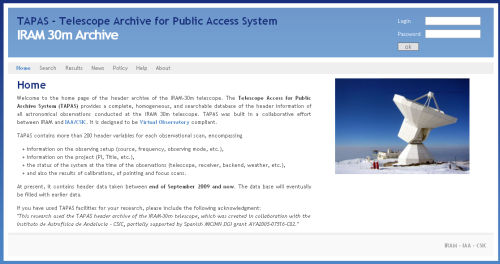The VO radio data model and archives
Technological Developments
The VO radio data model and archives
The great diversity of the current astrophysical instrumentation allows us to obtain information of the Universe in almost the whole electromagnetic range. This is stored in astronomical archives, but the nature and access methods to them is very heterogeneous. It is for the millimetric and submillimetric astronomy where the astronomical archives are less available, which adds difficulty for those non-radioastronomers when reducing and interpreting the data. The concept of Virtual Observatory (VO) was created aiming to solve the mentioned hetereogenity. The VO aims to offer an integrated system to access a number of archives which are very different among them, as well as a set of services that can interact both direct or remotely over them at different levels.
We have been working on the design of a standard radio data model for VO data archives both coming from single dish or synthesis radiotelescopes. We used all VO proposed data models to build a VO compliant single-dish, multiple-feed, radio astronomical archive data model – RADAMS – that has been published as an Active IVOA Modeling Efforts note. We have undertaken the implementation of this data model in several radio archives: the DSS-63 VO Archive and TAPAS (Telescope Archive for Public Access System) IRAM 30m VO Archive. The developments of these two VO compliant radio archives and the query interfaces have been performed in the context of a collaboration between the AMIGA group and both the Institut de Radio Astronomie Millimétrique (IRAM) in Sierra Nevada and the Spanish Virtual Observatory (SVO).
We are contributing to the development of IVOA standards for the discovery, access and remote analysis of multidimensional data (i.e. radiointerfometric velocity datacubes). We undertook a study of the state of the art VO standards for multidimensional data discovery (J.E. Ruiz, Master Thesis, Dec 2010) that was presented at the 2010 Fall IVOA Interoperability Meeting as the base of B0DEGA HI Archive prototype. This prototype archive is being extended into a more generic Simple Image Access SIAv2 Archive Prototype whith other datacubes coming from WHISP collection, implementing full characterization of each dataset following IVOA efforts in Data Modelling, as well as with specific remote services providing derived datasets or representations (i.e. moments, slices, channel maps, renzograms, etc.). This archive served also as prototype for datalink VO standard.
A subsample of our WHISP collection is also served using a HIPs (Hierarchical Progressive Survey) service. HiPS is an IVOA initiative to provided hierarchical schemes for the description, storage and access of sky survey data. The system is based on hierarchical tiling of sky regions at finer and finer spatial resolution which facilitates a progressive view of a survey, and supports multi-resolution zooming and panning. HiPS uses the HEALPix tessellation of the sky as the basis for the scheme and is implemented as a simple file structure with a direct indexing scheme that leads to practical implementations.
We have also contributed to the development of an IVOA standard to describe generic remote computing web services. This is the Parameter Description Language (PDL) which has been developed in the Grid and Web Services IVOA Working Group. PDL intends to be a expressive language for self-descriptive web services exposing the semantic nature of input and output parameters, as well as all necessary complex constraints. It is indeed a step forward towards true web services interoperability, and in this sense we have developed a PDL Client as a Taverna Workbench plugin which benefits of web services interoperability when building web-services-based workflows. PDL client is part of Astrotaverna plugin also developed by AMIGA group.
Documentation
- Parameter Description Language
- TAPAS, a VO radio archive at the IRAM-30m telescope. Leon et al., 2012
- Building a VO-compliant Radio Astronomical DAta Model for Single-dish radio telescopes. Santander-Vela et al., 2012
- Multidimensional data in the VO, Ruiz , 2010
- Integration of tools and radioastronomical archives in the VO, Santader-Vela PhD, 2009
- Virtual Observatory activities in the Amiga group, Ruiz et al., 2008
